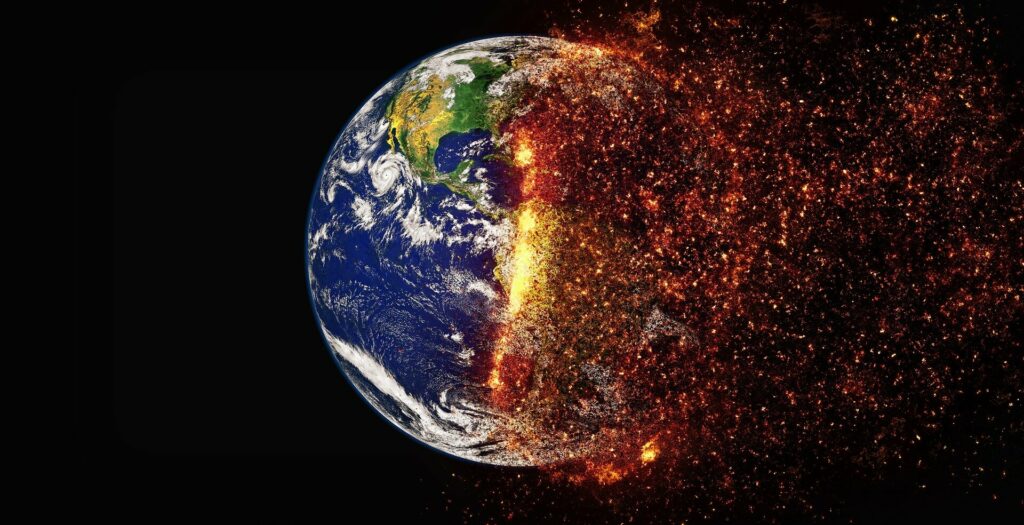In the spirit of the minister who read the Bible and the New York Times each day so that he’d know what both sides were thinking, we’re happy to share with you a new review paper by the famous James Hansen and 17 others you never heard of that tells us again that it’s all completely settled and worse than anyone predicted. Aaaaah! “Global warming has accelerated since 2010 by more than 50% over the1970-2010 warming rate of 0.18 °C per decade. Earth is now warmer than at any time in the Holocene, the past 11,700 years of relatively stable climate in which civilization developed, and it is at least as warm as during the extreme warm Eemian interglacial period 120,000 years ago.” It’s not, of course. There has been no statistically-detectable acceleration of warming. Also it was warmer in the Holocene Climatic Optimum, and in the Eemian, which while warmer than the Holocene was far from being “extreme warm” was only slightly above the Hoxnian or Purfleet, none of which saw elevated levels of CO2 and both of which were also warmer than the Holocene, as was the La Bouchet. Nor has the Holocene been “relatively stable”, what with the Younger Dryas, dark age cooling, Little Ice Age and such like. But what is mere science when there is a world to save? Hence the article’s title “Global Warming Has Accelerated: Are the United Nations and the Public Well-Informed?” suggests rather unsubtly that we might be doing PR here rather than science in the old-fashioned pursuit-of-knowledge sense. But it’s interesting to see what the PR is all about to know what they’re thinking.
BTF
Underscoring the seriousness of this new kind of science the authors include near the beginning a ghastly image of Faust selling his soul to the devil, to illustrate, uh, something. The paper does eventually make as its core science argument that there’s been a lot of aerosol cooling due to naughty human non-carbon pollution, which masked the hideous impact of the carbon kind. And now that we’re cleaning up our act on aerosols, why the temperature is soaring. Never mind El Niño and the 2022 underwater Hunga Tonga-Hunga Ha’apai blast. Or all the evidence that aerosols aren’t doing what scientists thought they were doing.
OK, do mind them. But in an odd way. Despite HT-HH hurling vast quantities of water vapour into the atmosphere, including the stratosphere, and water vapour being the most important greenhouse gas by a country mile, they confidently tell their computer to tell them that “aerosol cooling dominated over water vapor warming and the net volcanic forcing declined to a small fraction of its peak value by two years after the eruption” and it duly told them so.
As for El Niño, they say:
“Global temperature increased 0.4 °C during the recent moderate El Niño…a warming much greater than during even the strongest prior El Niños. This rapid warming has baffled leading Earth scientists, who, for example, conclude that no combination of known mechanisms for warming ‘has been able to reconcile our theories with what has happened.’”
So scientists say scientists can’t say. But Hansen et all set the scientific consensus aside with an impatient gesture:
“We conclude, on the contrary, that the known drives [sic] for climate change, principally human-made greenhouse gases and aerosols, account for observed global temperature, including a jump in sea surface temperature that amplified warming during the El Niño and has caused the widely discussed 1.5 °C temperature threshold to be breached, for all practical purposes.”
Then they discuss the alarmist breakthrough “into public attention” in 1988 while modestly leaving out that it was one J. Hansen who led the charge. Heck, are these my past glories, folks? Aw shucks.
It’s quite the paper. For instance they dispose of the famous “Holocene condundrum” that temperature and CO2 do not correlate for virtually the whole of the current interglacial even though:
“CO2 is a tight control knob on global temperature at other times in the ancient paleo record (see Figure 2 in Note 1 at end), as anticipated on theoretical grounds.”
There is, alas, no Figure 2 in Note 1 at the end, and the only “Figure 2” in the whole paper is “Faustus contemplates bargain with Mephistopheles” which may not be everyone’s idea of a scientific proof. We suspected the reference might be to the famous study that found a tight correlation between temperature and CO2 over the past 485 million years by kluging temperature and CO2 records and glossing over the fact that even so they didn’t correlate through the entire nearly 200-million-year Mesozoic. (But who’s counting?)
Instead a long hunt through formats and links brought us eventually to one of those fairly well known ice-core charts of temperature and CO2 over the last 800,000 years in which those not wedded to those famous “theoretical grounds” can see that CO2 is fairly plainly lagging temperature most of the time. Which is, shall we say, inconvenient.
Speaking of references, we did find one to RCP8.5, in Figure 15, which does exist in the original paper. So what we have here is, to a remarkable degree, the Golden Oldies of alarmism, in the halcyon days before the theory started coming apart at the seams over things like, for instance, findings that aerosols in the pre-industrial era played a larger role than climate orthodoxy likes to believe, and a smaller role since.
Since we at CDN believe in open minds, we suggest you read the paper for yourself, to see what they are thinking and judge whether they should be. However it would be unfair to end without noting that Hansen and his host of co-authors, or whatever they were, take issue with one piece of current orthodoxy if not of that from the 1980s and 1990s:
“Tipping points are a big concern in popular and scientific discussion of climate change. The most dire belief is that today’s accelerated warming is a sign of runaway feedbacks that are pushing climate beyond multiple tipping points, thus causing global warming acceleration that threatens eventual collapse of civilization. Our analysis does not support such beliefs. Instead, we find that observed acceleration of global warming is caused by a human-made climate forcing: reduction of atmospheric aerosols, especially aerosols produced by commercial shipping.”
They even suggest that some features of the climate system are what engineers call “negative gain governors” tending to tamp down rather than fire up instabilities. Though they also throw in the good old melting of the West Antarctic ice sheet as “the Point of No Return”. And then they shut down the ocean currents for bad measure:
“Our climate simulations led to the staggering conclusion that continued growth of ice melt will cause shutdown of the North Atlantic and Southern Ocean overturning circulations as early as mid-century and ‘nonlinearly growing sea level rise, reaching several meters in 50-150 years.’”
(The quotation marks are because here they’re quoting themselves, as in another paper by Hansen and 18 co-authors including nine from this one, from 2016.)
Then the paper takes an odd turn:
“The Secretary General of the UN in the past few years has made increasingly frantic statements about the urgency of actions to stem global warming, but in the context of unrealistic appraisal of the possibility of achieving the goal of the Framework Convention on Climate Change. Frank admission of the status of climate change and the implausibility of limiting global warming to a level below 2 °C with the present policy approach is needed. Realistic assessment is needed to help evaluate the actions that are needed to provide the best chance to attain and preserve a propitious climate and environment for today’s young people and their descendants.”
Um OK. Guterres is a raving nit. We knew it. But what to do instead? Apparently warming is going to continue, and so will fossil fuel use. We knew those things too. We could also have written:
“Imaginary, implausible, scenarios are harmful. Misleading plans for ‘net zero’ emissions by midcentury – while present policies guarantee that high fossil fuel emissions will continue – disguise failure to face reality. How is it that the United Nations advisory structure appears to be so oblivious of real-world energy needs and the time scale on which fossil fuel emissions will realistically be brought down?”
And how about this bit?
“Contrary to hype of some environmental organizations, fossil fuels are not a narcotic pushed on the public by an evil industry; they are a convenient condensed form of energy that has helped raise the standard of living in much of the world.”
You don’t say. Followed by you shouldn’t say:
“The realpolitik is: as long as the global commons are available as a free dumping ground for pollution, most nations with fossil fuel reserves will exploit those reserves. A radical change of global climate policy is needed, as discussed in our final section below. Given this grim picture, what is our basis for optimism? Why do we believe that it is realistic to avoid passing the Point of No Return? Our optimism is based on the growing interest of young people in the condition of the world that they and their descendants will live in, and in their conviction that they should follow the science.”
Aaaargh. They have a point about the tragedy of the commons, but CO2 is not pollution. Nor is the interest of young people in the environment a new thing. Remember Earth Day? Started in 1970? That thing? Greta Thunberg? If anything the youth of today are less into this stuff than the former youth of yesteryear.
Then they start blathering about “Global injustice” and “Intergenerational injustice” and call for a carbon tax used to redistribute income. Oh, and:
“Governments also must assure that adequate carbon-free technology is available.”
Can we also have a pony, and some world peace? Or indeed, and they do call for it, some nuclear reactors?
Apparently we can also have our snowball Earth and eat it too:
“We do not recommend implementing climate interventions, but we suggest that young people not be prohibited from having knowledge of the potential and limitations of purposeful global cooling in their toolbox.”
Prohibited? How?
By this point the kitchen sink is jostling the blender, linoleum, cupboards and everything else for space in this weird summary of Hansen’s lifetime work. And though we’ve said “they” throughout the piece because of its listed legion of co-authors, it actually lapses revealingly into the first person singular toward the end, almost as if it were Hansen with a host of hangers-on who maybe contributed small technical bits to it that didn’t include copy-editing. As for instance:
“In 2008-2009, Peter Barnes and I, respectively, tried to persuade the U.S. Congress that ‘cap-and-dividend’ and ‘fee-and-dividend’, were much superior to cap-and-trade.”
Also “I went to a dozen other countries to talk about climate change” and:
“I am a political independent in part because, it seems to me, that provides the best chance of looking at problems without an initial preference about the answer.”
Well, no. One is a political independent as a result of forming an opinion about what the parties are saying and not much liking either, as the provisional result of reasoning, not its starting point.
There’s no question that what we have here is Hansen, now well into his eighties, summing up what climate change theory was in his glorious youth. And it’s worth paying attention to, for its glimmers of insight and for what it gets stubbornly wrong. You do want to know what both sides are thinking.



NASA’s. CERES (Cloud and the Earth Radiant Energy System) satellites have monitored earth ‘s cloud albedo since 2001. The albido has been reducing so
more solar radiation is reaching the surface and warming the atmosphere. Nikolov and Zeller
have a recent paper showing the high statistical correlation (0.8) of the albedo vs an average of 6 temperatures sets. Nikolov has a lecture on Youtube with Tom Nelson detailing the results . Worth
watching and understanding. He concludes that
since reduced cloud albedo can explain all the recent warming the GH effect does not exist.
[Apparently no one bothered to ask James how his current claim (2024 quoted by NOAA as having a GMT of 15.19 oC) squares with his earlier claim as quoted in The New York Times {March 29, 1988}, as using the “30-year period 1950 – 1980, when the average global temperature was 59oF or 15oC, as a base to determine temperature variations.”]
The weak author of this article reveals his incompetence when he starts talking about CO2 as a feedback, long before humas began adding CO2 to the atmosphere as a forcing
CO2 caused TMIN warming, with a moest water vapor positive feedback, and SO2 caused TMAX warming could explain all the warming since 1975. Not necessarily right. But the Tonga volcano explanation is wrong.
That volcano had no effect on GAT in the first month and any effect gradually weakens over time. ... El Ninos are offset by La Ninas in the long run: ENSO is temperature neutral.
Cloud data are inaccurate , and only a proxy for what we really need to know. The measured change was too small to be statistically significant. The small reduction in the percentage of cloud cover (-7%) suggests some TMAX warming but could be deceptive. The ACTUAL solar energy blocked by clouds depends on cloud type, cloud height and cloud timing. CERE does NOT answer those questions with the cloud percentage statistic. ... The cloud data in the past 20 years is a proxy for what we really need to know
The small decrease of cloud cover does not explain why most of the post-1975 warming has been TMIN near dawn, not affected by sunlight. In fact, fewer clouds in the day suggests fewer clouds at night. Fewer clouds at night reduce the greenhouse effect. Fewer clouds would cause more TMAX warming and less TMIN warming, but the opposite has been happening since 1975,
Also, the stratosphere was cooling since 1980, exactly what was expected from a stronger greenhouse effect ... which is measured daily , ad is ot a fantasy,